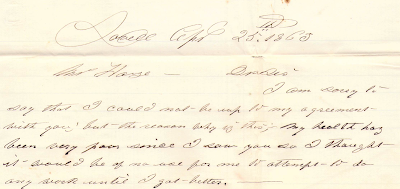Unearthing History: A Peek into a Letter from 1863
Tucked away in the folds of history, a letter from 1863 reveals a slice of life during a tumultuous time in American history. Addressed to a Mr. Ichabad Hauze and referencing a 'Carriage Matter,' this missive offers intriguing glimpses into personal and public affairs of the era. Although the writing is difficult to decipher, it presents a fascinating opportunity to delve into the historical context and events surrounding its composition.
Historical Context
Our journey begins in Waterford City, Maine, as mentioned in the letter. This small town, settled in 1775, was centered around where Kedar Brook emptied into Keoka Lake. Most of the buildings, including the oldest surviving one, the Lake House, were constructed before 1850. Between 1850 and 1900, a small number of Italianate and transitional Greek Revival-Italianate buildings were added to the district. Notable among these was the Leander Stone House, built around 1870, and the 1879 Masonic Hall, also constructed by Stone. The civic buildings, primarily of Colonial Revival style, were mostly built before 1930.
National and Local Events
In 1863, the United States was in the midst of the Civil War, with several major battles taking place in June of that year. The Battle of Brandy Station, Virginia, the Second Battle of Winchester, and the Battle of Aldie all ended inconclusively. In a significant political development, West Virginia was admitted as the 35th U.S. state on June 20th.
The Carriage Matter
While the term 'Carriage Matter' in the letter remains ambiguous, it could potentially refer to issues related to employment, transportation, or more specifically, carriages. An interesting event of note around this time was an accident involving Mary Lincoln, the First Lady, in July 1863. While traveling from the presidential summer retreat, the presidential carriage's driver's seat detached, causing the horses to run wild and Mary Lincoln to leap from the carriage to save herself.
Unresolved Mysteries
Despite extensive research, we couldn't uncover definitive information about Mr. Ichabad Hauze or the author of the letter. The name 'Maxfield' appears, possibly as a courier or middleman, but no further details could be found. The letter suggests a personal or business relationship between Mr. Hauze and the author, who apologizes for failing to uphold an agreement due to ill health. While we may not know the specifics, the letter provides an intimate glimpse into the personal trials faced by individuals during this time.
As we step back from this unique document, we are reminded of the rich tapestry of history, woven from grand events and personal stories alike. This humble letter, though filled with uncertainties and mysteries, provides a tangible connection to the past and the people who lived through it.



